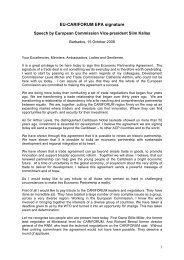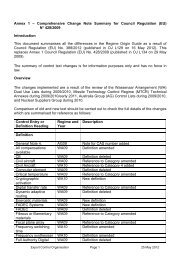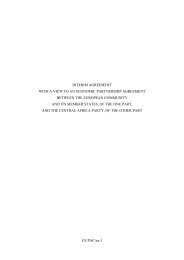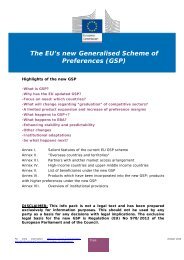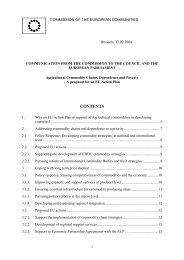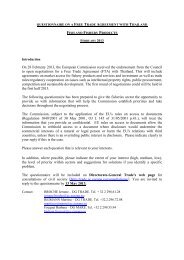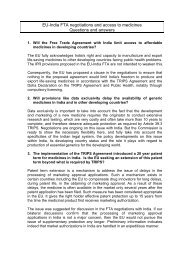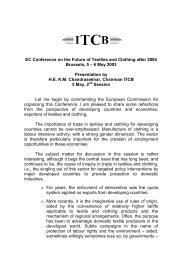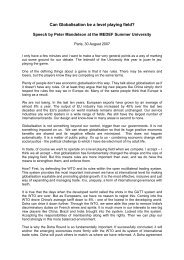Report on the Implementation of the derogation to ... - Trade Websites
Report on the Implementation of the derogation to ... - Trade Websites
Report on the Implementation of the derogation to ... - Trade Websites
You also want an ePaper? Increase the reach of your titles
YUMPU automatically turns print PDFs into web optimized ePapers that Google loves.
Final <str<strong>on</strong>g>Report</str<strong>on</strong>g><br />
RoO Derogati<strong>on</strong> under <strong>the</strong> PACP-IEPA<br />
b) <strong>Trade</strong> diversi<strong>on</strong><br />
Given <strong>the</strong> dynamics <strong>of</strong> competiti<strong>on</strong> for <strong>the</strong> extra-EU import market, <strong>the</strong> complexity and flux <strong>of</strong> world<br />
ec<strong>on</strong>omic c<strong>on</strong>diti<strong>on</strong>s, and <strong>the</strong> range <strong>of</strong> commercial and political struggles over resource and market<br />
access, it is deemed unrealistic <strong>to</strong> project trade diversi<strong>on</strong> scenarios for particular exporting<br />
countries. 332 It is possible though <strong>to</strong> combine his<strong>to</strong>rical trends <strong>of</strong> market share by EU market with a<br />
qualitative understanding <strong>of</strong> <strong>the</strong> positi<strong>on</strong> <strong>of</strong> third countries in <strong>the</strong> EU-centred value chain <strong>to</strong> arrive at<br />
some c<strong>on</strong>sidered possibilities <strong>of</strong> which will be most likely <strong>to</strong> be effected by medium term projecti<strong>on</strong>s<br />
for PNG exports.<br />
Two growth scenarios are assumed for <strong>to</strong>tal extra-EU import volumes <strong>of</strong> canned tuna, and <strong>on</strong>e<br />
growth scenario for tuna loins. For each growth scenario PNG market share is calculated according<br />
<strong>to</strong> <strong>the</strong> projected export volumes <strong>to</strong> <strong>the</strong> EU detailed in Table 6.11. These projecti<strong>on</strong>s form <strong>the</strong> basis<br />
for assessing <strong>the</strong> impacts <strong>of</strong> global sourcing <strong>on</strong> <strong>the</strong> three main categories <strong>of</strong> third countries identified<br />
earlier (i.e. African IEPA, Latin American GSP+ and Sou<strong>the</strong>ast Asian GSP). No attempt has been made<br />
<strong>to</strong> predict future tuna prices, so no account is provided <strong>of</strong> changing values or value shares <strong>of</strong> canned<br />
tuna or loin markets.<br />
Growth scenario for extra-EU import volumes <strong>of</strong> canned tuna I: relative market stagnati<strong>on</strong><br />
Given <strong>the</strong> unexpected decline in extra-EU27 canned tuna imports in 2009-10, a scenario <strong>of</strong> relative<br />
stagnati<strong>on</strong> in this market has been assumed. To do so a five-year average has been taken for extra-<br />
EU imports (2006-2010), which includes <strong>the</strong> highest ever volume in recorded imports (i.e. 2007) and<br />
333<br />
<strong>the</strong> lowest since 2002 (i.e. 2010). Based <strong>on</strong> <strong>the</strong>se assumpti<strong>on</strong>s <strong>the</strong> projected extra-EU import<br />
volume in 2016 is around 404,400 mt. Based up<strong>on</strong> projected PNG exports <strong>to</strong> <strong>the</strong> EU in 2016 <strong>of</strong><br />
around 56,705 mt, PNG could capture up <strong>to</strong> 14.0% share <strong>of</strong> a relatively stagnant extra-EU import<br />
market for canned tuna (from 4.3% in 2010).<br />
Growth scenario for extra-EU import volumes <strong>of</strong> canned tuna II: mild market growth<br />
Alternatively, it might be assumed that <strong>the</strong> extra-EU canned tuna import market returns <strong>to</strong> growth<br />
(perhaps spurred <strong>on</strong> by austerity-driven c<strong>on</strong>sumpti<strong>on</strong> <strong>of</strong> cheap, healthy animal protein, by market<br />
promoti<strong>on</strong>s and/ or by newly emerging canned tuna markets such as Poland). In this scenario we<br />
take <strong>the</strong> growth rate for <strong>the</strong> last seven years before <strong>the</strong> 2009-2010 drop <strong>of</strong>f in imports (i.e. a market<br />
expansi<strong>on</strong> <strong>of</strong> 1.21 times between 2002 and 2008). When applied <strong>to</strong> extra-EU import volumes in 2010<br />
we arrive at a higher estimate for 2016 <strong>of</strong> around 448,527 mt. Based up<strong>on</strong> projected PNG exports <strong>to</strong><br />
<strong>the</strong> EU in 2016 <strong>of</strong> around 56,705 mt, PNG could capture up <strong>to</strong> 12.6% share <strong>of</strong> a mildly expanding<br />
extra-EU import market for canned tuna.<br />
334<br />
Under both <strong>of</strong> <strong>the</strong>se scenarios, potential PNG share <strong>of</strong> <strong>the</strong> extra-EU canned tuna import market is<br />
significantly less than that <strong>of</strong> <strong>the</strong> two largest third country suppliers in recent years (i.e. Thailand and<br />
Ecuador (see Table 6.14)). In light <strong>of</strong> this finding, <strong>the</strong> c<strong>on</strong>sultants c<strong>on</strong>cur with Oceanic<br />
Développement (2010) that <strong>the</strong> noti<strong>on</strong> that <strong>the</strong> EU market would be ‘flooded by imports from PNG<br />
332 These variables are slightly more stable in <strong>the</strong> intra-EU market due <strong>to</strong> its dominati<strong>on</strong> by <strong>on</strong>e locati<strong>on</strong> <strong>of</strong><br />
producti<strong>on</strong> (i.e. Spain).<br />
333 See Table 6.6 for <strong>the</strong> data used here.<br />
334 Of course, <strong>the</strong> extra-EU import market may grow far more rapidly than expected. For example, producti<strong>on</strong><br />
by Spain-based processors might c<strong>on</strong>tract after its recent increases and/or Spanish processors may <strong>of</strong>fshore<br />
more producti<strong>on</strong> <strong>to</strong> Latin America. Alternatively, austerity-driven c<strong>on</strong>sumpti<strong>on</strong> and/ or newly emerging canned<br />
tuna markets may drive absolute market expansi<strong>on</strong>. We are using two c<strong>on</strong>servative growth scenarios because<br />
projecting more optimistic scenarios entails a complex interplay <strong>of</strong> variables that is bey<strong>on</strong>d <strong>the</strong> scope <strong>of</strong> this<br />
report.<br />
Linpico s.a.r.l. Page 165




